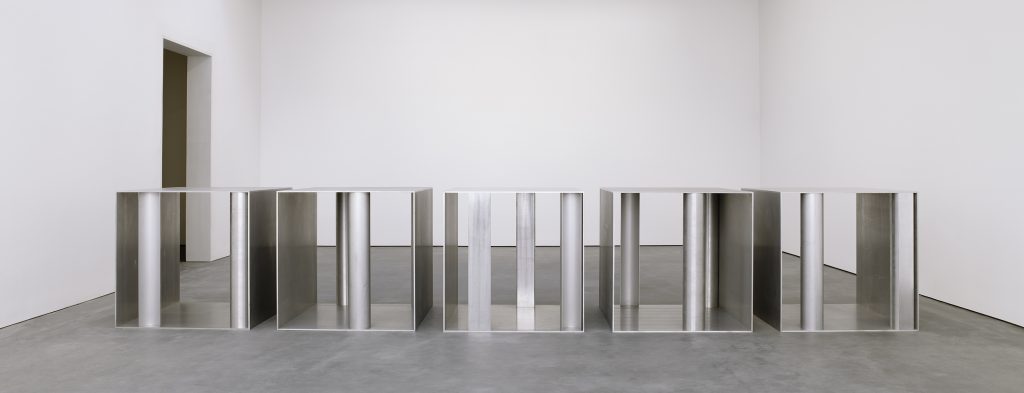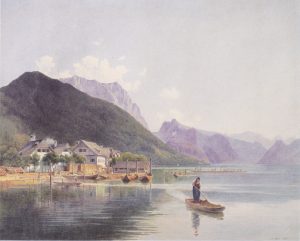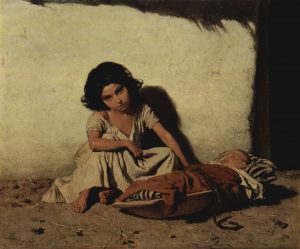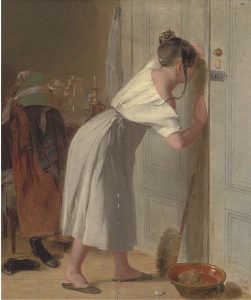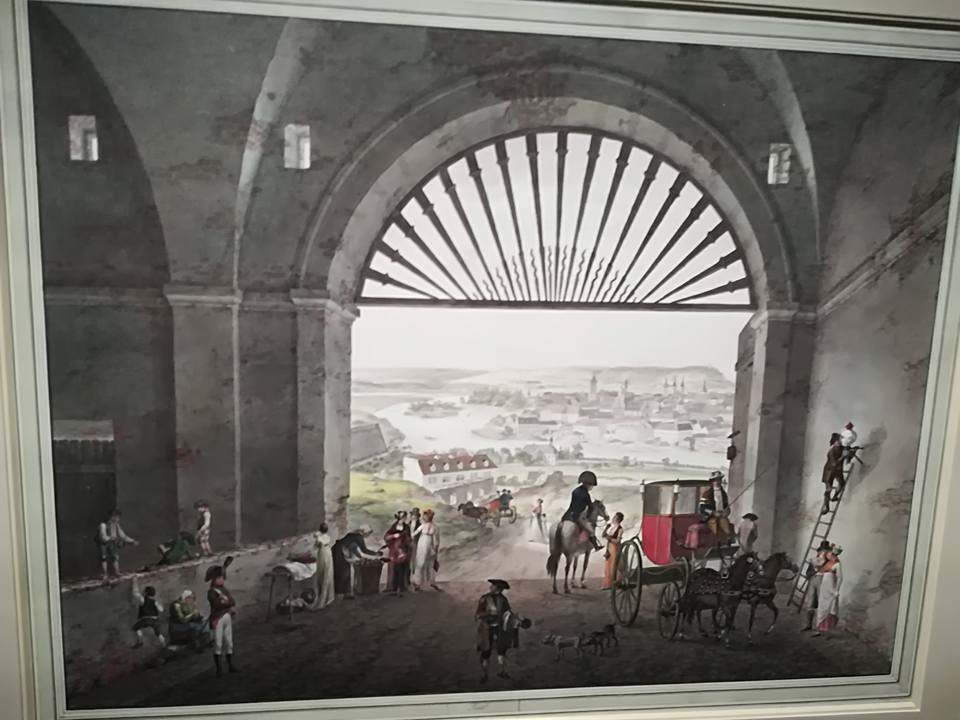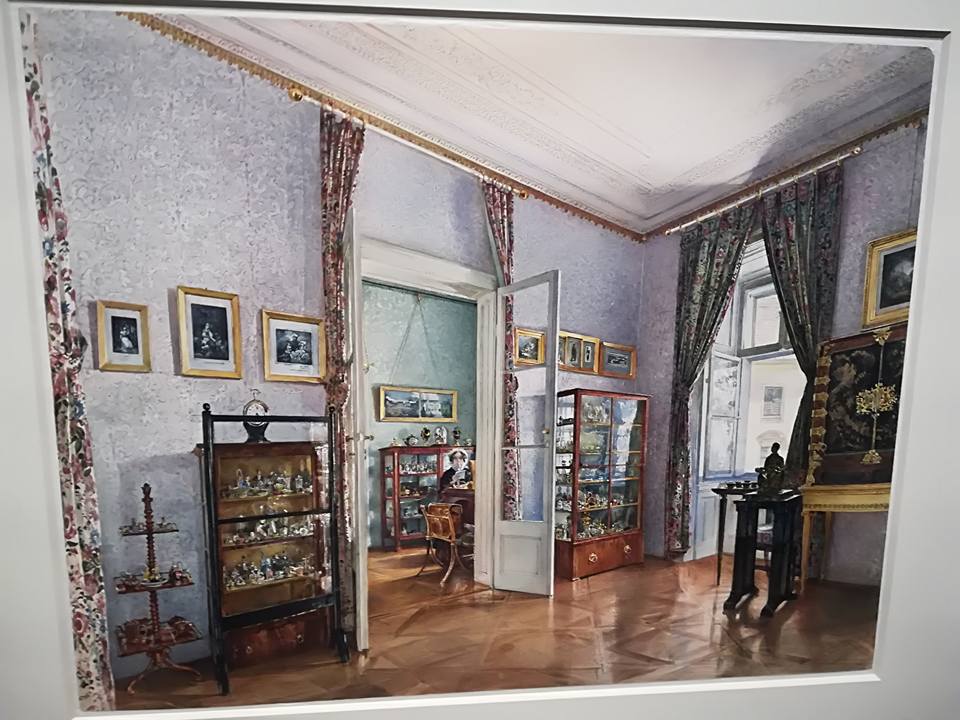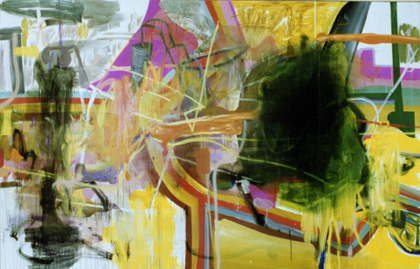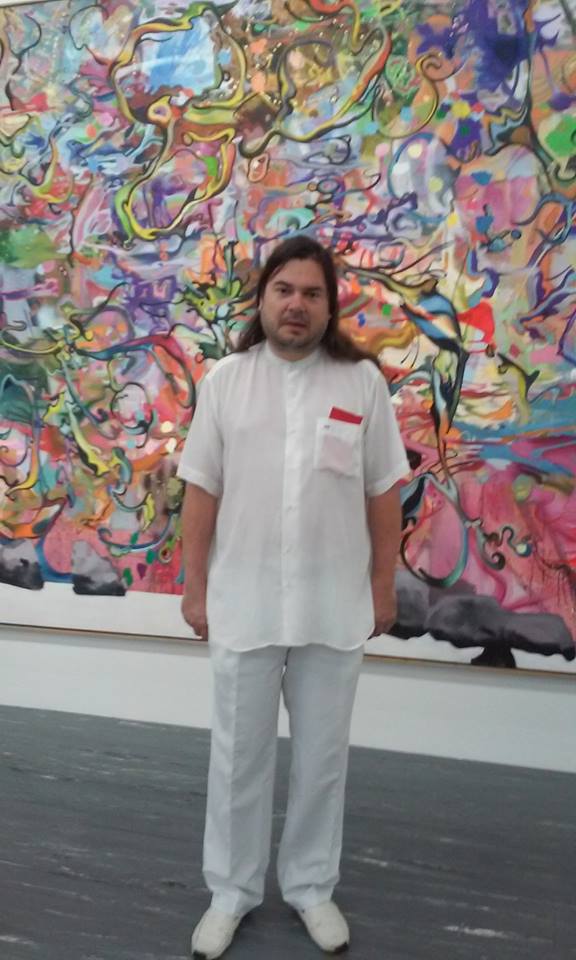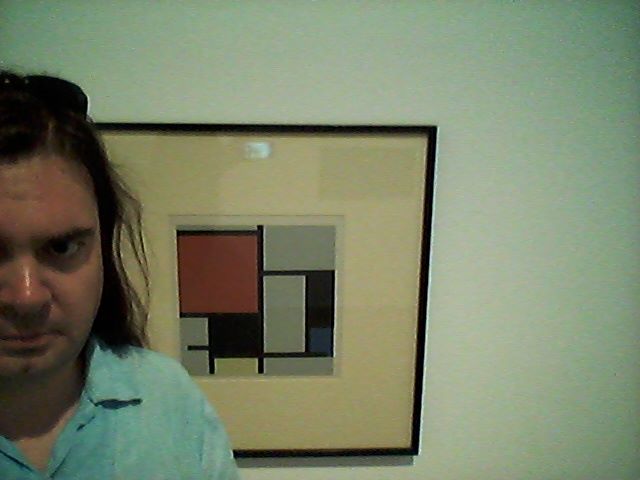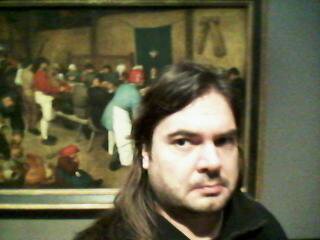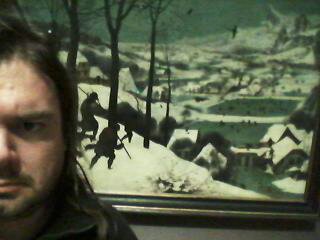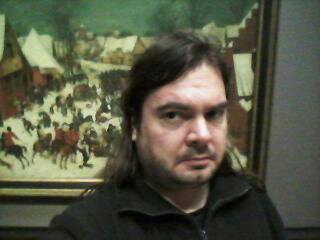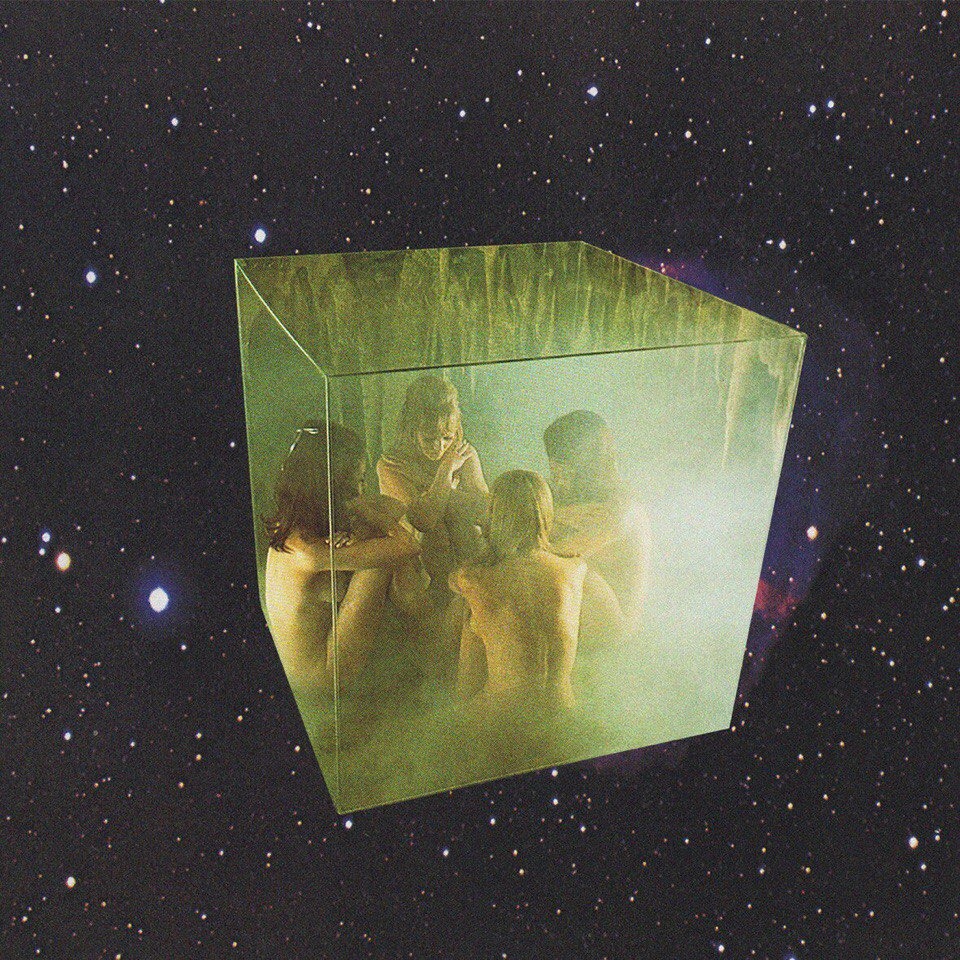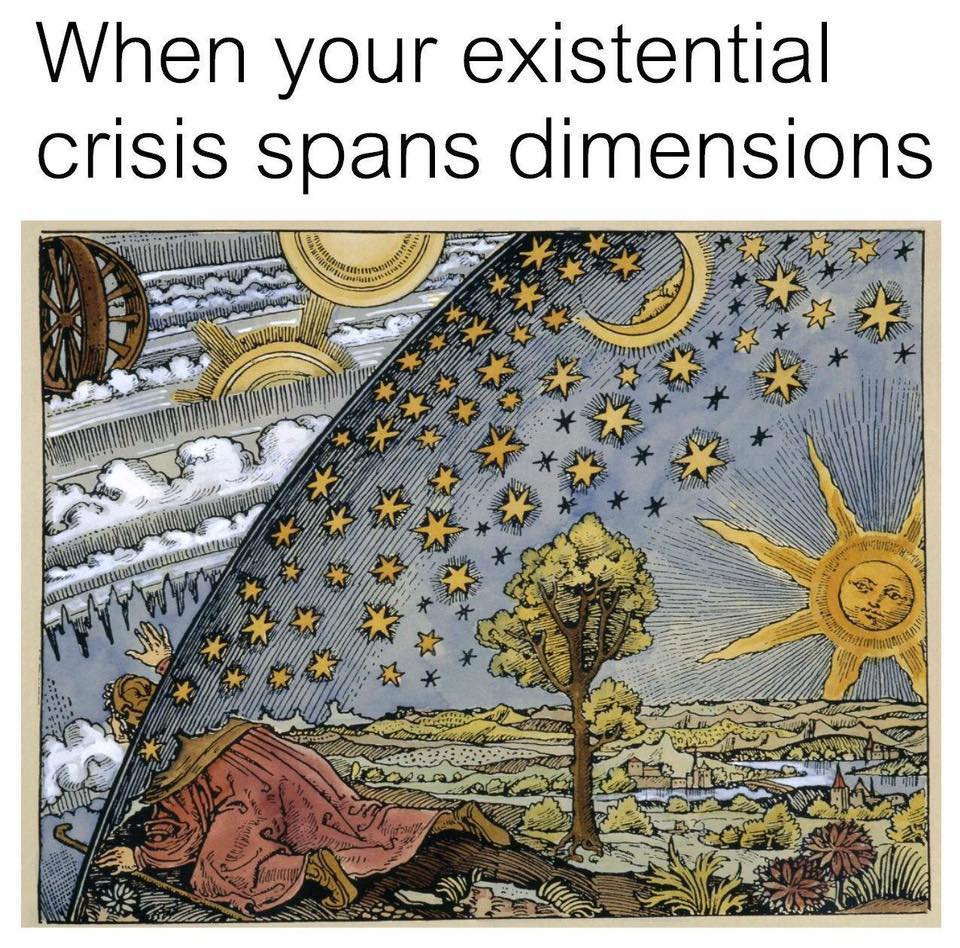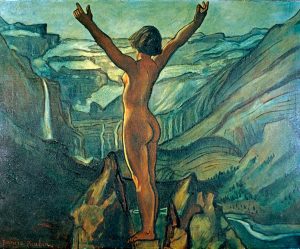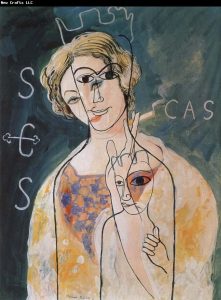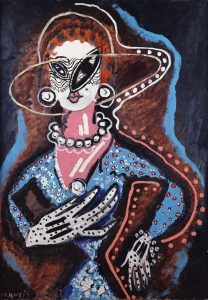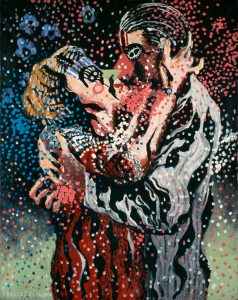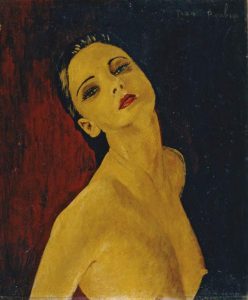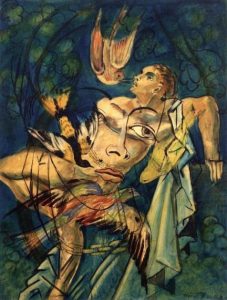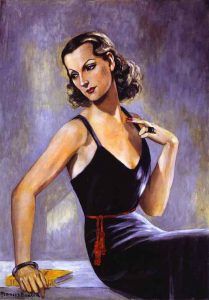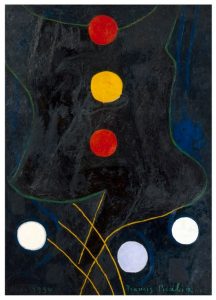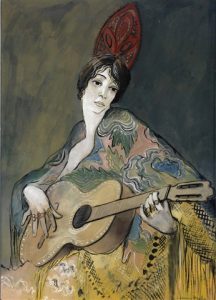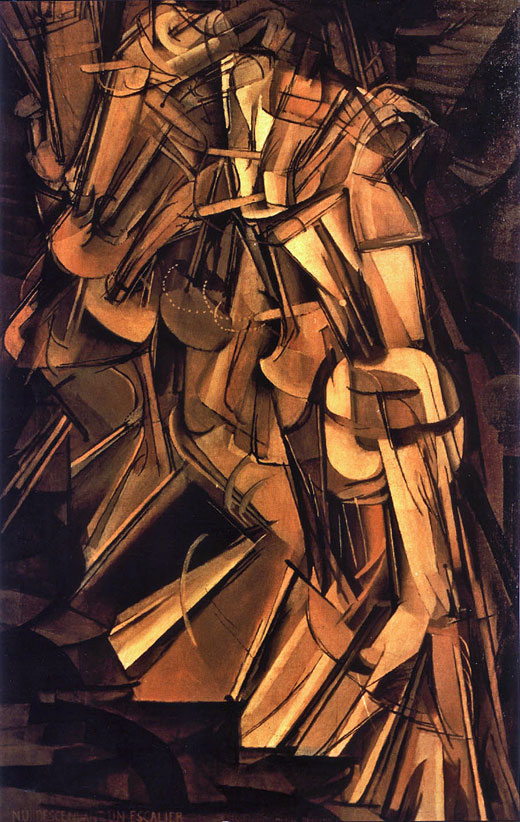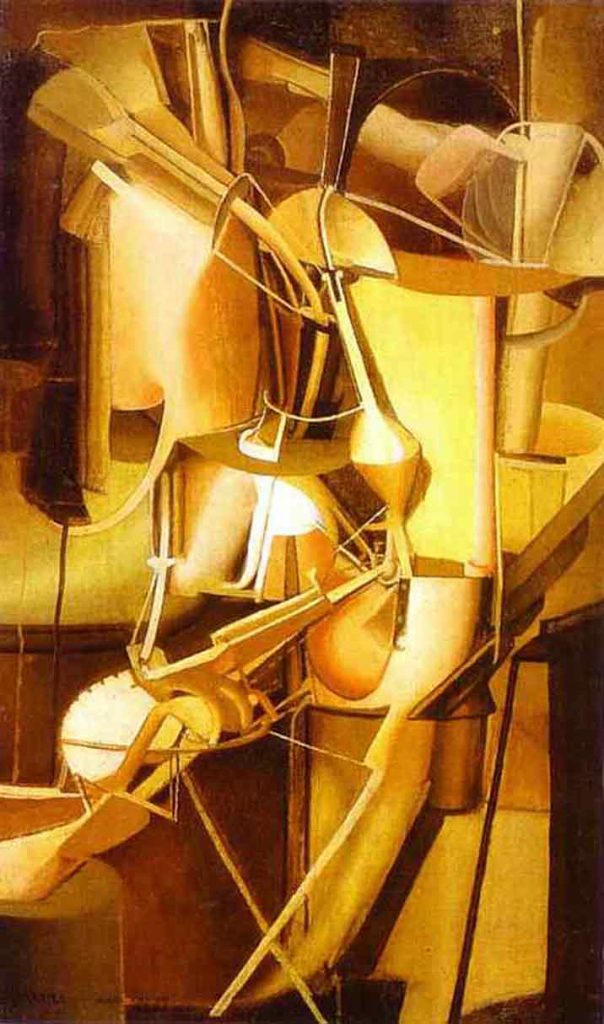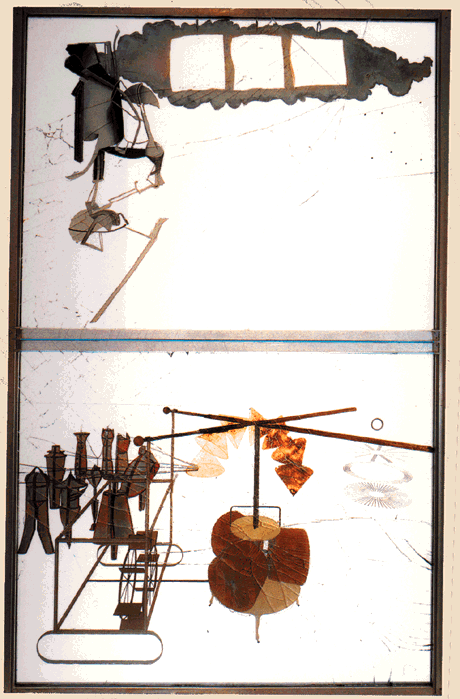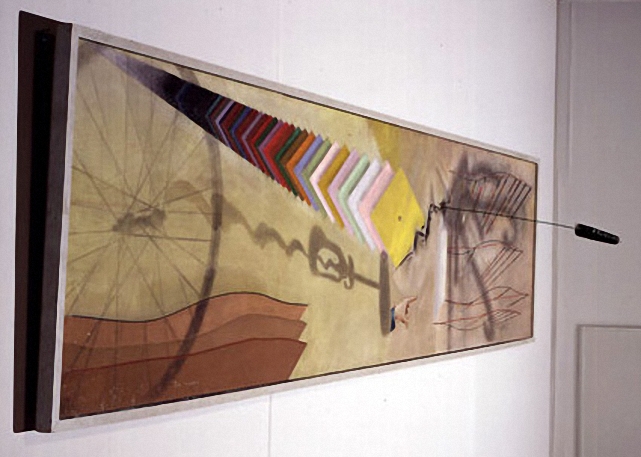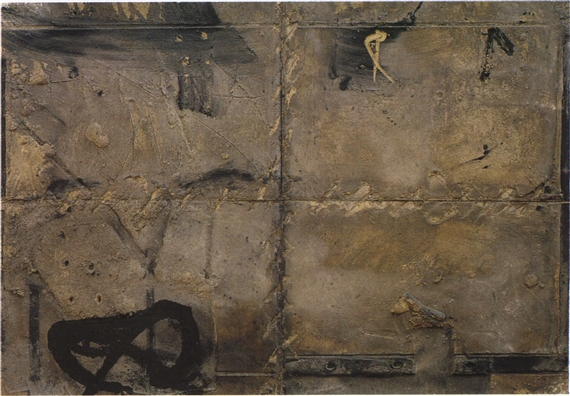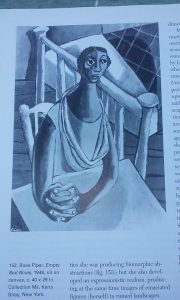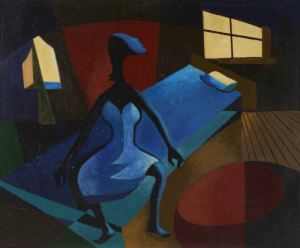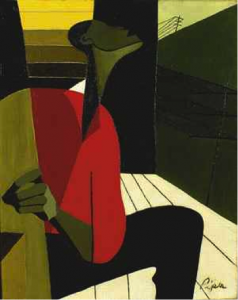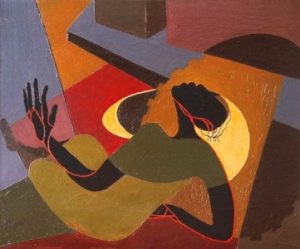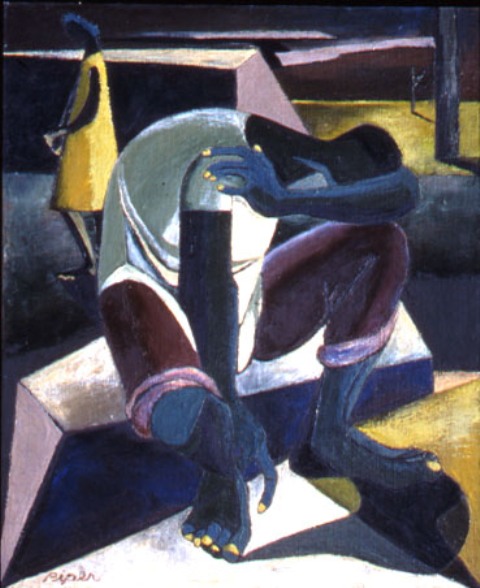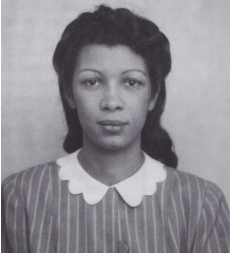„Now the world is neither meaningful nor absurd. It simply is… In place of this universe of „meanings“ (psychological, social, functional), one should try to construct a more solid, more immediate world. So that first of all it will be through their presence that objects and gestures will impose themselves, and so that this presence continues thereafter to dominate, beyond any theory of explication that might attempt to enclose them in any sort of a sentimental, sociological, Freudian, metaphysical or any other system of reference.“
(Robbe-Grillet, cited in Barbara Rose: „ABC Art“, an influential article about minimal art published in „Art in America“ in 1965)
 Call it the Apollonian, but reduction to essence, bringing into form, carving the unnecessary out, introducing some silence, being elliptic is a major element within the art conquest; in becoming ever more minimalistic, stuff seems to become ever more invincible and undisputable – think of a child wrapping a box up respectively making something like the box via minimalistic wrapping, busily and affirmingly it says „So!“, „So!“, „So!“ when completing each step towards perfection, finally there is this silly, silent box and the child standing there, looking up to the grown up (or to deity), arms crossed behind the back: as if it says: „I have done everything right! There is nothing to be disputed anymore! You cannot catch and nail me anymore! You can groan and moan as much as you want, but…“, etc. Hail to the child! Likely, within all that the human child is a bit unsure, as it lacks orientation in the world, and eschatological knowledge, but in wrapping up the minimalistic box it has come up with something assertive and is aware of that; the adult-deity may rejoice or at least twist his mouth and move his head back a bit, as he is defeated, at least for a while. Hail to the child! It has achieved some manifestation in the world. Take a look at Robbe-Grillet´s statement there above! Aaahh… the world, and its metaphysics not being made by reference to the celestial world, but by the blunt encounter and relationships between subjects and objects within the world, maybe unforeseeable in their implications, yet often, and normally, to remain only a reference to an empty potential! Minimalists challenged the notion of sculpture and object in the 1960s as they placed some minimalistic forms in space, opening the possibility of interaction with the recipient (for instance also to be experienced as an obstacle that stands in the way)! The grid of the world as a relational structure! By reducing stuff into minimalistic forms that, due to their sharp and essential geometry, are both more real and less real than the objects you encounter in the world, you have, in minimalism, the disposability (and Zuhandenheit) as well as the unavailability of things, and of the things that make up this world. Remember that numbers or ideal geometric forms refer to the virtual, and therein also minimal art refers to the virtual via a paradoxial intervention, as, by taking out any specific content, those artworks actually refer to nothing, they´re neutral and inexpressive. But what they are is that they are present, and therein, you encounter presence in both its most manifest as well as elusive form. You have a metaphysics of pure presence, as well as a metaphysics of neutrality and a metaphysics of boredom. Somehow, those minimalist works seem to be so autonomous (and, as feminist critics claimed, masculine-sharp-assertive, whereas in the works of female artists somehow linked to minimal art, like Eva Hesse, you have some quasi-organic, soft, biomorphic forms and flows and the like). Due to not having much in them, minimal art refers to quietism, to Zen, to a transsubjective world-continuum – and Lucy Lippard calls Robert Morris a „master of formal silence“. For the creative mind, silence contains the virtuality of the clamour of being, therein, minimal art indicates the possibility of all creation. Those minimalistic forms are enigmatic, as they both refer to basal elements of construction, yet also to virtual ideals that are beyond any construction. Ahhh, what a dialectics! It brings opposites together, the small and the infinite (?)! Pseudo-immanence and pseudo-transcendence! Those squarelike forms of minimal art adress the square in me! The boxes of Donald Judd are some kind of rivets that hold the subjective and the objective universe together, they´re an encounter (like the installations of Sarah Sze)! Very mysterious, all this! In another context, there may be a trajectory from minimal art to degeneration of art via the growing preeminince not of the artwork but of the kunstähnliche Gegenstand (artlike object) from the 1970s onwards. Finally, indeed, there is actually not so much to say about them minimal objects, but that is good, since it binds the hallucinatory endless depths of imagination back to something solid and concrete, an anchor. In a world of ambiguity, objects attached with meaning etc. you encounter pure, literal forms that have nothing to tell and signify and you can endlessly explore what they speak to you. Glory! Glory! Glory! Glory!
Call it the Apollonian, but reduction to essence, bringing into form, carving the unnecessary out, introducing some silence, being elliptic is a major element within the art conquest; in becoming ever more minimalistic, stuff seems to become ever more invincible and undisputable – think of a child wrapping a box up respectively making something like the box via minimalistic wrapping, busily and affirmingly it says „So!“, „So!“, „So!“ when completing each step towards perfection, finally there is this silly, silent box and the child standing there, looking up to the grown up (or to deity), arms crossed behind the back: as if it says: „I have done everything right! There is nothing to be disputed anymore! You cannot catch and nail me anymore! You can groan and moan as much as you want, but…“, etc. Hail to the child! Likely, within all that the human child is a bit unsure, as it lacks orientation in the world, and eschatological knowledge, but in wrapping up the minimalistic box it has come up with something assertive and is aware of that; the adult-deity may rejoice or at least twist his mouth and move his head back a bit, as he is defeated, at least for a while. Hail to the child! It has achieved some manifestation in the world. Take a look at Robbe-Grillet´s statement there above! Aaahh… the world, and its metaphysics not being made by reference to the celestial world, but by the blunt encounter and relationships between subjects and objects within the world, maybe unforeseeable in their implications, yet often, and normally, to remain only a reference to an empty potential! Minimalists challenged the notion of sculpture and object in the 1960s as they placed some minimalistic forms in space, opening the possibility of interaction with the recipient (for instance also to be experienced as an obstacle that stands in the way)! The grid of the world as a relational structure! By reducing stuff into minimalistic forms that, due to their sharp and essential geometry, are both more real and less real than the objects you encounter in the world, you have, in minimalism, the disposability (and Zuhandenheit) as well as the unavailability of things, and of the things that make up this world. Remember that numbers or ideal geometric forms refer to the virtual, and therein also minimal art refers to the virtual via a paradoxial intervention, as, by taking out any specific content, those artworks actually refer to nothing, they´re neutral and inexpressive. But what they are is that they are present, and therein, you encounter presence in both its most manifest as well as elusive form. You have a metaphysics of pure presence, as well as a metaphysics of neutrality and a metaphysics of boredom. Somehow, those minimalist works seem to be so autonomous (and, as feminist critics claimed, masculine-sharp-assertive, whereas in the works of female artists somehow linked to minimal art, like Eva Hesse, you have some quasi-organic, soft, biomorphic forms and flows and the like). Due to not having much in them, minimal art refers to quietism, to Zen, to a transsubjective world-continuum – and Lucy Lippard calls Robert Morris a „master of formal silence“. For the creative mind, silence contains the virtuality of the clamour of being, therein, minimal art indicates the possibility of all creation. Those minimalistic forms are enigmatic, as they both refer to basal elements of construction, yet also to virtual ideals that are beyond any construction. Ahhh, what a dialectics! It brings opposites together, the small and the infinite (?)! Pseudo-immanence and pseudo-transcendence! Those squarelike forms of minimal art adress the square in me! The boxes of Donald Judd are some kind of rivets that hold the subjective and the objective universe together, they´re an encounter (like the installations of Sarah Sze)! Very mysterious, all this! In another context, there may be a trajectory from minimal art to degeneration of art via the growing preeminince not of the artwork but of the kunstähnliche Gegenstand (artlike object) from the 1970s onwards. Finally, indeed, there is actually not so much to say about them minimal objects, but that is good, since it binds the hallucinatory endless depths of imagination back to something solid and concrete, an anchor. In a world of ambiguity, objects attached with meaning etc. you encounter pure, literal forms that have nothing to tell and signify and you can endlessly explore what they speak to you. Glory! Glory! Glory! Glory!
Minimalist sculptures somehow challenge ancient notions as they are not, tradionally, sculptures, also not, traditionally, objects – they are rather forms and work as systems or systemic inventions in environment (or carry within themselves the possibility of their own extension or reduction like in the cases brought upon by Sol de Witt). However, they create the impression of dumb objects, of materiality, or of ideal forms, to try to push and slide and emerge into this world, make themselves important, underline their presence; seem to say „Here I am, man… what will you now do against me?“ They´re there. They´re, maybe, middle-range objects that came to inhabit this world as well, out of unknown reason and for unkown purpose, and where dialogue and domestication is, to some degree, possible, to some other degrees not (check out also the note about Charles Sheeler and his eloquently silent industrial architectures). They seem to be vivid, stupid, and mysterious, follow their own (reduced, but also ungraspable) logic, like Kafka´s Odradek. In Realismus Jetzt, a Merve book edited by Armen Avenessian which is about speculative philosophy and metaphysics for the 21st century, there is a contribution by philosopher Graham Harman about his „Object Orientated Ontology“ (OOO) in which he wants to give dignity to things and tries to introduce an understanding of things being an essential element of metaphysics and to be philosophised upon (he even says that, corresponding to the „linguistic turn“ in 20th century philosophy, we´d need an „object turn“ in our century). He makes reference to Heidegger´s tool analysis (which he claims to be the hidden truth of all Heidegger´s metaphysics), and also to the „humming universe“ of the friendly metaphysicist Whitehead. Remember that Heidegger speaks of zuhandenem Zeug, objects/tools that are there in the world and, as tools, may change man´s possibilities of access to the world, respectively the world itself, implicating that objects/tools is stuff that is metaphysically relevant, that seem to be somehow autonomous, carry potential and may be game-changing (what is not mentioned in the short article is Heidegger´s philosophy about technology, as a force that, in a somehow conservative fashion, he saw as alienating and incorporating a life and logic of its own that is somehow stronger than that of man and therefore, finally, a heteronomy upon the man´s world). (Opposed to other philosophical traditions, Heidegger´s philosophy does away with a lot of categorial stuff and focuses on man as being rather „spontaneously“ in the world and navigating through the world, and changing it, i.e. Heidegger´s man is not a well-defined (and therein limited) man, but a rather fluid creature, i.e. Heidegger´s epistemology is rather a contact theory, like the one I have recently encountered in the book by Hubert Dreyfus and Charles Taylor.) Whitehead, as we remember, develops an ontology where everything (every single entity, as basal elements of reality) is connected in a network that makes the („humming“) universe. That is nice and friendly. However, says Graham, where Heidegger does not have a lot to say about things as that they both reveal (entbergen) and conceal (verbergen) themselves, Whitehead somehow implicates a notion of an instable or overly colourful universe that can be changed every instant, which is rather not the case: in doing away with the notion of substance – which seems to implicate a stickiness that isn´t exactly there –, network ontologies like that of Whitehead seem to do away with structure and seem to implicate a flexibility (or creativity) that is also not exactly there (although there is only an indication but not necessarily a reason for coming up with such a critique since substance-ontologies may contain network-notions and vice versa, and if I remember correct, Whitehead is not stupid or one-dimensional in his thinking). At other occasions (lectures to be found on Youtube) Graham Harman stresses the importance of an object orientated ontology by saying that if we reduce (meta)physics of objects, we could not explain phenomena of emergence, whereas if we put to much emphasis on substantial notions we could not explain change (hm…). OOO introduces some mysteriousness into the world, a notion of the cryptic potency of inanimate things that is potentially much more potent than pure human potency, and he also makes reference to aesthetics and the arts – that the notion of a world that is not completely „given“ at any moment, but a world that is partially withdrawn is actually what is captured/reflected in the arts, respectively illuminated in the multidimensional mind of the artist that „reveals“ the hidden truths of man and the universe (Graham, by contrast (on that occasion) says that in the arts objects become „mysterious“ and „withdrawn“ —– let us remember that in art the place of objects and the meanings of things become dislocated and put into other context, therefore you may have a certain disassociation: but for the reason of showing how the thing actually works and to reveal its existential ontology and its meta-noumenon!). (Graham also discusses minimalism shortly in here (47:30) <3 although the connection between minimalist art and object ontology sprang to my mind independly.) In diving into the hidden depths of the „withdrawing“ world, Graham Harman also mentions the „negative theology“ of Pseudo-Dionysius (i.e. that God indicates himself in this world via an absence that can be mystically approached and experienced, and that the light of God is a „dark“ light).
Very interesting and metaphyscial! I have got me some books by Graham Harman and want to get more closely in touch with OOO and then maybe write a note about it (which could make a Postscript to the Metaphysical Note about Extreme Metal). I think with his notion of a „withdrawing“ world that is never fully given he may refer to complexity – and it may be that complexity is a true phenomenon there in the world i.e. that is ontologically given (complicatedness means: something is more or less complicated and difficult to see through, but can be solved and defined; complexity means: you have an ever changing system whose interactions cannot be entirely foreseen — in his lecture Graham Harman refers to the social sciences as a science that has to operate with a complex flux, but also economics may come to mind (or meterology, or hydrodynamics, etc.). In his paper The Trouble With Macroeconomics Paul Romer explains how describing and computing an economic system involves a matrix of mxm parameters, but their interdependence is described by only m equations; hence complex systems probably cannot ever be captured by mathematics, implying that mathematics is not the deep/universal language of the universe, etc.) I also ask myself the question what is the Ding an sich of a car? Or of petrol? Or of a toaster? Or of an institution? That is relatively easy to say, think however of how the ancient wheel relates to the car etc. Feynman says, what we can construct we understand (with reference e.g. to the brain or consciousness which we cannot construct so far and probably never can), does that mean we see the thing in itself of the respective issue? I also wonder how potent things/objects/tools ever are; some popular notions, like that of McLuhan describe medias/tools as extensions/protheses of man; however when I read ancient Chinese literature like the Classic novels of China, I am astonished how similar people actually are across time and across culture; also Stanislaw Lem mourns or satirises about far (technologically) advanced future civilisations which are, to considerable extent, primitive and childish nevertheless (i.e. maybe tools and machines aren´t actually that important).
Dear Phillip:

